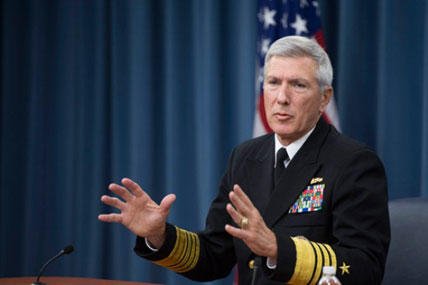The Navy needs more attack submarines and surface ships to land Marines to counter growing threats across the Pacific, the head of U.S. Pacific Command said Tuesday.
"The reality is that to get Marines around effectively, they require all types of lift. They require the big amphibious ships" and the landing craft to take them ashore, but the defense cutbacks have limited the supply, said Adm. Samuel Locklear.
Locklear said he competes against the demands of combatant commanders in other parts of the world for amphibious ships.
"There is a global competition among us. In the Pacific, though, it is my view that as the Marines come back [from Afghanistan] that we should optimize the capability of the Marines -- particularly in the area west of the [International] dateline. And to do that we have to have adequate amphibious lift," Locklear said.
Locklear's concerns on budget cuts were echoed by Army Gen. Curtis M. "Mike" Scaparrotti, head of the United Nations Command and U.S. Forces-Korea.
Scaparrotti said the 28,500 U.S. troops in South Korea were adequately prepared to defend and repel a North Korean attack across the De-Militarized Zone, but he worried about the readiness of follow-on forces.
"The forces in theater have been fully resourced despite the budget constraints we've had," Scaparrotti said. "I am concerned about the readiness of the follow-on forces. I rely on prepared and ready forces to flow into the peninsula in times of crisis."
In joint testimony before the Senate Armed Services Committee, both Locklear and Scaparrotti stressed that China could do more to enhance stability in the region and ease the concerns of neighboring states.
As North Korea's sole major ally, China should exert more influence to rein in North Korean dictator Kim Jong-un, Scaparrotti said.
"I believe we've seen some results in the muted rhetoric of Kim Jong-un in the last several months," Scaparrotti said of Chinese pressure. "I think there's much more that they could do. To this point they've been unwilling to take any more steps as far as I can tell," Scaparrotti said.
The economic sanctions imposed on North Korea by the U.S. and its allies in an effort to pressure Kim into negotiating on dismantling his nuclear programs have had little result, Scaparrotti said.
"They're not all being met," Locklear said of his attack submarine needs.
Locklear agreed with Ayotte's assessment that the current Navy plan was to decrease the number of attack submarines from 55 to 42 by 2029 while China's submarine fleet was expected to grow to about 70.
Locklear said that "unfortunately" the current budget constrints had forced the Navy to reduce the attack submarine fleet to 42.
"It comes down to managing risk and where we can absorb risk," Locklear said.
On the proposed rebalance of U.S. forces to the Pacific, Locklear said the U.S. was still committed to the plan to have 60 percent of U.S. forces in the Pacific and 40 percent elsewhere despite the budget constraints and growing threats in other regions.
Doubts have been raised about the viability of the "Pacific pivot" in Congress and even in the Pentagon.
"Right now, the pivot is being looked at again, because candidly it can't happen" in the current fiscal climate, Katrina McFarland, the assistant secretary of Defense for Acquisition, said at an Aviation Week conference earlier this month. Later that same day, McFarland issued a follow-up statement saying "the rebalance to Asia can and will continue."
At a hearing on March 6, Rep. Howard McKeon, R-Calif., warned that the Pacific rebalance could not be reconciled with the current budget.
"The administration has committed to a rebalance to the Asia-Pacific while also sustaining a heightened alert posture in the Middle East and North Africa," McKeon said.
The available evidence "suggests that we can't do both, or if we do, we do so at an increased risk to our forces and their missions," McKeon said.
-- Richard Sisk can be reached at richard.sisk@monster.com



























